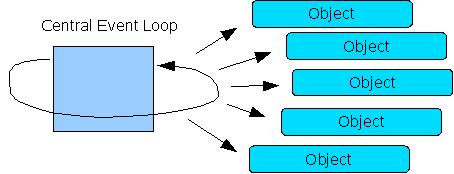Difference between revisions of "Architecture/Proposal/Advanced Threading-Architecture"
From Apache OpenOffice Wiki
m (Added category.) |
m (Slightly improved.) |
||
| Line 1: | Line 1: | ||
| − | + | State: draft | |
| + | Type: Proposal | ||
| − | + | ==Advanced OOo Threading Architecture== | |
| + | The advanced threading architecture aims to solve OOs multi threading and concurrency problems. | ||
| − | + | ===Problem=== | |
| − | * Not calling blocking system calls leads to 'short' lasting mutex acquisitions. | + | The following list gives a brief overview, of where the problems lie, |
| + | * unresponsive user interface, | ||
| + | * busy waiting (e.g. frequent re-schedule or yield calls), | ||
| + | * scalability with multiple threads, in particular when doing API programming, | ||
| + | * operations (e.g. loading, saving, printing etc.) are not interruptable. | ||
| + | |||
| + | ===Solution=== | ||
| + | OOo must be changed to be purely event / callback driven. | ||
| + | |||
| + | The following list gives a first idea, of what should be done, | ||
| + | * all (potentially) blocking calls need to be event driven, | ||
| + | * all long lasting calls need to be executed by dedicated threads, notifying the consumers via events / callbacks, in case data is available, | ||
| + | * asynchronous signals need to be mapped to events, | ||
| + | * Windows window messages need to be mapped to events, | ||
| + | * the threading architecture must be defined high level, e.g. | ||
| + | ** concurrency per application, or | ||
| + | ** concurrency per document. | ||
| + | |||
| + | ====Pros==== | ||
| + | * Not calling potential blocking system calls leads to 'short' lasting mutex acquisitions. | ||
* No hand crafted reschedules necessary anymore. | * No hand crafted reschedules necessary anymore. | ||
* Easy utilization of Hyper Threading, multi cores and SMP. | * Easy utilization of Hyper Threading, multi cores and SMP. | ||
| Line 11: | Line 32: | ||
* One single location where to create threads. | * One single location where to create threads. | ||
| − | + | ====Cons==== | |
* (assumed to be) Hard to implement. | * (assumed to be) Hard to implement. | ||
Revision as of 16:00, 6 July 2006
State: draft Type: Proposal
Advanced OOo Threading Architecture
The advanced threading architecture aims to solve OOs multi threading and concurrency problems.
Problem
The following list gives a brief overview, of where the problems lie,
- unresponsive user interface,
- busy waiting (e.g. frequent re-schedule or yield calls),
- scalability with multiple threads, in particular when doing API programming,
- operations (e.g. loading, saving, printing etc.) are not interruptable.
Solution
OOo must be changed to be purely event / callback driven.
The following list gives a first idea, of what should be done,
- all (potentially) blocking calls need to be event driven,
- all long lasting calls need to be executed by dedicated threads, notifying the consumers via events / callbacks, in case data is available,
- asynchronous signals need to be mapped to events,
- Windows window messages need to be mapped to events,
- the threading architecture must be defined high level, e.g.
- concurrency per application, or
- concurrency per document.
Pros
- Not calling potential blocking system calls leads to 'short' lasting mutex acquisitions.
- No hand crafted reschedules necessary anymore.
- Easy utilization of Hyper Threading, multi cores and SMP.
- Controlable CPU utilization and possible avoidance of over utilization.
- 'Simple' architecture.
- One single location where to create threads.
Cons
- (assumed to be) Hard to implement.
Pseudo Code for event loop:
void dispatch(int signal) {
switch(signal) {
case SIGIO:
fileHandler(getHandle());
break;
case SIGTERM:
...
}
}
int quit;
sigset_t sigset;
int main(void) {
int signal;
while(!quit) {
sigwait(&sigset, &signal);
dispatch(signal);
}
return 0;
}
